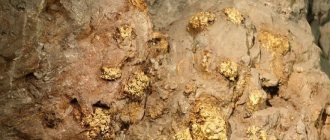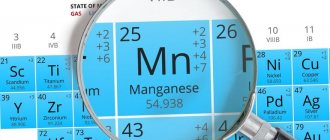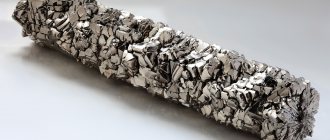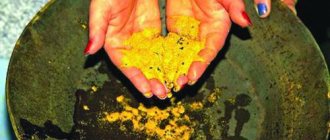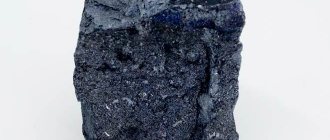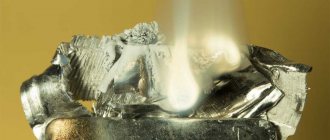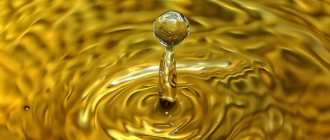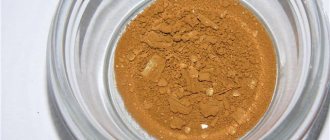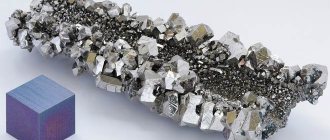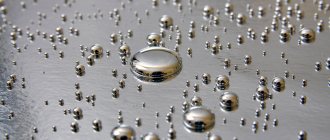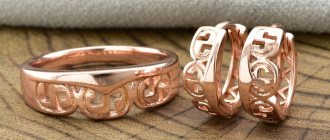Gold on Igor Garshin's website
Home
| Write |
Home > Evolution of nature > Evolution of matter > Atoms > Gold
Alphabetical list of pages: | | | | | E (Yo) | | | | | | | | | | | | | | | | | | | | | | | | 0-9 | AZ (English)
| Atoms are the Lego of nature. |
Gold (lat. Aurum), Au, chemical element of group 1 of the Mendeleev periodic system; atomic number 79, atomic mass 196.9665; a heavy yellow metal classified as noble. Consists of one stable isotope 197Au.
The reviews are given in accordance with the encyclopedic articles by S. A. Pogodin and A. I. Stadnichenko.
Sections of the page about gold as a substance and material :
- Physical and physico-chemical properties of gold
- Chemical properties of gold and its compounds - see also geochemistry of gold
- Gold in nature - see also gold fields and gold-bearing nodes
- Historical background on the use of gold
- Gold recovery - see also gold exploration and mining
- Gold in the noosphere (application)
- Gold in the biosphere and in medicine - see also about the biogenic concentration of gold
- Online reviews about gold
- Network news about gold
- Bibliography on gold
Physical and physico-chemical properties of gold
| GOLD (Aurum) Au, chemical. element I gr. periodic systems, at. n. 79, at. m. 196.9665; refers to noble metals . There is only one stable isotope in nature, 197Au. External configuration electron shell 5d106s1; oxidation states +1, +3, rarely +5; ionization energies of Au0 : Au+ : Au2+ : Au3+ are respectively 9.2258, 20.5 and 30.5 eV; Pauling electronegativity 2.4 electron affinity 2.8 eV; atomic radius 0.144 nm, ionic radii (coordination numbers are indicated in parentheses) Au+ 0.151 nm (6), Au3+ 0.082 nm (4), 0.099 nm (6). 3 gold - yellow metal; crystalline face-centered lattice cubic, a = 0.40786 nm, z = 4, space. Fm3m group. Gold is a soft, very ductile, malleable metal (can be forged into sheets up to 8·10-5 mm thick, drawn into wire, 2 km of which weigh 1 g): Mohs hardness ~ 2.5, Brinell hardness 220-250 MPa ; elastic modulus 81 GPa; srast 10-25 MPa. Gold conducts heat and electricity well. |
- The crystal lattice of gold is face-centered cubic, a = 4.704 A.
- ⚛ Atomic radius 1.44 A, ionic radius Au1+ 1.37 A.
- tmelt 1064.43°C, tkp 2947°C (the value 2880°C is also given); thermal coefficient of linear expansion 14.2·10-6 (0–100°С);
- temperature coefficients linear expansion (5.98-19.10).10-6 K-1 (40-1200 K), volumetric (1.79-5.73).10-5 K-1 (40-1200 K); thermal conductivity 318 W/(m.K) at 273 K; r (2.06-2.84).10-8 Ohm.m (273-373 K), temperature coefficient. r 4.0.10-3 K-1 (273-373 K);
- specific thermal conductivity 311.48 W/(m K) [0.744 cal/cm (sec °C]; specific heat capacity 132.3 J/(kg K) [0.0316 cal/g °C] (at 0° -100°С);
- electrical resistivity 2.25 x 10-8 ohm (m (2.25 x 10-6 ohm (cm)) (at 20°C); temperature coefficient of electrical resistivity 0.00396 (0-100°C).
- С0p 25.39 J/(mol.K); DH0pl 12.55 kJ/mol, DH0sp 348 kJ/mol; S0298 47.40 J/(mol.K);
- level of temperature dependence of vapor pressure: for solid 3. logp (hPa) = 3.94 - 19820/T - 0.3061gT - 0.16.10-3 T (298-1337 T), for liquid logp (Pa) = 10.710 + 17866/T (1337-3150 K);
- diamagnetic, magnetic susceptibility -29.59.10-6.
- The density of solid gold is 19.32 g/cm3 (at 20°C), liquid gold is 17.22 g/cm3 (1100°C);
- Elastic modulus 79·103 MN/m2 (79·102kgf/mm2), for annealed gold tensile strength 100–140 MN/m2 (10–14 kgf/mm2), relative elongation 30–50%, narrowing of cross-sectional area 90% .
- After plastic deformation in the cold, the tensile strength increases to 270–340 Mn/m2 (27–34 kgf/mm2). Brinell hardness 180 MN/m2 (18 kgf/mm2) (for annealed gold about 400 °C).
Gold is very resistant to chemical influences. It is stable in air and water. Does not interact directly with O2, H2, N2, P, Sb and C. Phosphide Au2P3 (DH0arr -102 kJ/mol) and antimonide AuSb2 (DH0arr - 13 kJ/mol) are obtained indirectly.
3 gold does not dissolve in solutions of alkalis and solutions, sol. in hot H2SeO4, mixtures of H2SO4 with HNO3, H2SO4 with HMnO4, as well as in aqua regia (HCl + HNO3): Au + HNO3 + 4HCl: H[AuCl4] + NO + 2H2O; after careful evaporation, yellow crystals of complex chloroauric acid HAuCl4.3H2O are released. In aqueous solutions of cyanides (Na, Ca, K) with access to O2 or other oxidizing agents, gold dissolves. with the formation of dicyanoaurate ion (cyanidation): 2Au + 4CN- + H2O + 0.5O2: 2[Au(CN)2]- + 2OH-, which underlies the most important industrial process. method of extracting gold from ores. Gold does not interact with halogens in the absence of moisture without heating; when heated. gold powder in a halogen atmosphere, gold halides are formed.
Gold forms alloys with many metals. One of the methods for extracting gold from rocks is based on the easy formation of gold amalgam. Conn. gold is unstable, hydrolyzes in aqueous solutions, and is easily reduced to metal.
Gold catalysis
It is difficult to find another substance in the world that would play such an ominous role in the history of civilization. Raised by human labor to the pedestal of a sovereign measure of value, element No. 79 became a symbol of inhumanity in class society.
Gold history of discovery properties and alloys
To please the “god of gold,” during the Middle Ages, entire nations and the great civilizations that had been created in the Western Hemisphere were completely destroyed. And today millions more people on earth live in the world of the “yellow devil,” which “surrounds a person with its web, drowns him out, sucks blood and brain, devours muscles and nerves...”
But, of course, this element No. 79 in itself is no more guilty of all these atrocities than element No. 92 is to blame for the destruction of Hiroshima.
In pursuit of the precious metal, numerous geographical and other discoveries were made, and the volume of information on the basis of which chemistry subsequently arose was significantly expanded.
For many hundreds of years, alchemists, inspired by the tempting goal of producing the “king of metals” from cheaper and more accessible materials, studied thousands of substances and reactions.
Gold history of discovery properties and alloys
In search of the “philosopher’s stone”, they carried out countless experiments, developed the technique of chemical experiments and, in particular, the separation of mixtures and solutions, and obtained many previously unknown substances - acids, alkalis, salts.
The complete collapse of centuries-old attempts to turn “imperfect” metals into gold led to the establishment of the basic concept of chemistry - the concept of a chemical element.
Chemical properties of gold and its compounds
The configuration of the outer electrons of the gold atom is 5d10 6s1. In compounds, gold has valences of 1 and 3 (complex compounds in which gold is 2-valent are known).
Gold is characterized by its easy reduction from compounds to metal and the ability to form complexes. The existence of gold oxide, i.e. gold oxide (I) Au2O, is doubtful.
Gold does not interact with non-metals (except halogens). With halogens, gold forms halides, for example 2Au + 3Cl2 = 2AuC13. Gold dissolves in a mixture of hydrochloric and nitric acids, forming chlorauric acid H [AuCl4].
In solutions of sodium cyanide NaCN (or potassium KCN), with simultaneous access to oxygen, gold is converted into sodium cyanoaurate (I) 2Na. This reaction, discovered in 1843 by P.R. Bagration, received practical application only at the end of the 19th century. (see Cyanidation).
Gold(I) chloride AuCl is obtained by heating gold(III) chloride: AuC13 = AuCl + C12.
Gold(III) chloride AuC13 is obtained by the action of chlorine on powder or thin leaves of gold at 200 °C. Red needles of AuCl3 give a brown-red solution of complex acid with water: AuC13 +H2O=H2[AuOC13].
When a solution of AuC13 is deposited with caustic alkali, amphoteric yellow-brown gold(III) hydroxide Au(OH)3 with predominant acidic properties precipitates; that's why it's called golden acid
, and its salts -
aurats
(III). When heated, gold (III) hydroxide turns into gold oxide Au2O3, which above 220° decomposes according to the reaction: 2Au2O3 = 4Au + 3O2.
When gold salts are reduced with tin(II) chloride 2AuC13 + 3SnCl2 = 3SnCl4 + 2Au, a very stable purple colloidal solution of gold is formed ( Cassium purple
); this is used in analysis to detect gold. Quantitative determination of gold is based on its precipitation from aqueous solutions with reducing agents (FeSO4, H2SO3, H2C2O4, etc.) or on the use of fire assay.
Au(OH)3 hydroxide - dark brown crystals; when heated, it dehydrates to form first AuO(OH), and then sesquioxide Au2O3, which decomposes into gold and O2 above 160°C; solubility in water is 2.4.10-12 mol/l at 20°C, in HNO3 solutions - up to 0.38 mol/l at 25°C, in NaOH solutions - up to 8.10-4 mol/l at 25°C. In the latter case, gold is present in the solution in the form of hydroxoaurate ions [Au(OH)4]- (pH 7-13). Au(OH)3 is formed by adding a concentrated solution of alkali or Mg(OH)2 to solutions of H[AuCl4].
Auras are unstable and easily decompose when heated. Alkali metal aurates are highly soluble in water, solubility increases with increasing ionic radius of the cation; Mg, Ca, Sr, Ba, Tl(I) aurates have limited solubility. Aurates form explosive mixtures with some organic substances. It is assumed that when gold hydroxide is exposed to alkali solutions, aurate anions [H2AuO3]-, [HAuO3]2-, [AuO3]3- are formed. See also table. 2.
Other oxygen compounds of gold are unstable and easily form explosive mixtures. The compound Au2O3 with ammonia Au2O3.4NH3 is called “explosive gold”; explodes at 145°C, sometimes at lower temperatures; dissolves without explosion in solutions of alkali metal cyanides.
Gold hemisulfide Au2S - black-brown crystals; DG0arr 29 kJ/mol; poorly soluble in water (p-value product 4.10-69 at 25 °C), sol. in solutions of cyanides and polysulfides of alkali metals. Receive interaction. conc. solution K[Au(CN)2] with H2S from the last. heating to boiling with excess hydrochloric acid. Sesquisulfide Au2S3 - black crystals; decomposes when heated. up to 200 °C; not sol. in salt and sulfuric acid, sol. in HNO3 with the release of elemental gold, KCN solutions, bromine water. Receive interaction. H2S with AuCl3 or complex gold chlorides in anhydrous ether in the cold. Complex compounds containing the anions [AuS3]2-, [AuS2]-, [AuS]-, [Au(SO3)2]3-, [Au(S2O3)2]3- are known.
AuSe monoselenide exists in two crystalline forms. modifications of the monoclinic system. When treating gold hydrochloric acid solutions in the cold with hydrogen selenide, sesquiselenide Au2Se3.H2Se is deposited, which is stable (after drying) in the range of 40-390°C; at 535-650°C it decomposes with the release of elemental gold.
Selenate (IV) Au2(SeO3)3.3H2SeO3 lemon-yellow crystals; not sol. in water, sol. in salt and selenium (when heated) compounds.
Selenate (VI) Au2(SeO4)3 yellow crystals; DH0rev - 954 kJ/mol; not sol. in water, decomposes with hydrochloric acid, sol. in H2SO4, HNO3 and hot conc. H2Se04.
Telluride (hemitelluride) AuTe2 - crystals from brass-yellow to silver-white with metallic. shine; dense 9.3 g/cm, DH0rev - 11 kJ/mol; brittle, Mohs hardness 2.5-3.
AuSCN thiocyanate is colorless. crystals; not sol. in water and org. r-retailers; at 140°C decomposes to metallic. gold and (SCN)n; under the influence of water it forms strong complex anions [Au(SCN)2]- and [Au(SCN)4]- in solutions.
Colloidal gold
When restoring gold in the breakdown. solution of its salts, as well as with electric. By spraying gold in water, colloidal solutions of gold are formed, the color of which depends on the degree of dispersion of the particles, and the intensity of the color on their concentration. Gold particles in a colloidal solution are negatively charged. A hydrophobic gold sol in hydrochloric acid aqueous solution can be represented by the following diagram:
[Au]m is the core of the micelle (the number of atoms m, depending on the conditions, can vary from several hundreds to millions of units); AuCl4- - ions that determine the negative charge of the colloidal gold particle and the potential of the adsorption layer of thickness d0; H+ - counterions that determine the potential of the diffusion layer (electrokinetic potential), of which x ions are located in the blurred part of the double layer with thickness d; n is the number of AuCl4- ions adsorbed on the surface of the micelle core, while n
Gold as a means of payment
Gold became a universal means of payment only due to its properties. It is inert, so it hardly reacts to external factors. It does not dissolve, does not oxidize and does not change its state in the natural environment. Only in a special solution of “royal vodka” can this noble metal be completely dissolved. All these physical and chemical properties allow gold to exist quietly in nature in its natural pure form, which cannot be said about other metals.
Gold is characterized by a slight shine, it does not lose its appearance and does not melt. It is an excellent metal for forging. Due to this, it is considered the best for making jewelry. This metal can be mined on almost every continent. Most often this work is very labor-intensive and complex. Gold deposits are limited. For example, Russia is considered one of the countries that has large deposits of this metal (about 16 thousand tons). The cost of gold mining varies greatly depending on the country and deposit. It ranges from $110 to $350 per ounce. An ounce is a measure of precious metals of approximately 31.10 grams.
Gold in nature
Gold prevalence
The average gold content in the lithosphere (earth's crust) is 4.3·10-7% by mass, in sea and ocean water it is less than 5.10-6 mg/l. Refers to scattered elements. Gold is dispersed in magma and igneous rocks, but hydrothermal gold deposits of important industrial importance (quartz gold-bearing veins, etc.) are formed from hot waters in the earth’s crust. In ores, gold is mainly in a free (native) state and only very rarely forms minerals with selenium, tellurium, antimony, and bismuth. Pyrite and other sulfides often contain an admixture of gold, which is extracted during the processing of copper, polymetallic and other ores.
More than 20 minerals are known, of which the main one is native gold (electrum, copper, palladium, bismuth, etc.), which is a solid solution of silver (from traces to 43%) in gold and also containing Cu, Fe, Pb , less often - platinum group metals, Mn, Bi, etc. Chemical compounds of gold are rare in nature, mainly. these are tellurides - calaverite AuTe2, krennerite (Au,Ag)Te2, sylvanite AuAgTe4, petzite Ag3AuTe2, mutmannite (Ag,Au)Te, montbreuite Au2Te3, etc. 3gold is present Ch. arr. in quartz, carbonates, pyrite, arsenopyrite, galena, sphalerite, chalcopyrite.
Gold in deposits
In ores, gold is present in the form of inclusions of sizes b. h. 0.1-1000 microns, sometimes nuggets up to several are found. tens of kg. The destruction of endogenous gold deposits leads to the formation of gold placers of industrial importance.
Genetic types of industrial gold deposits: hydrothermal high-temperature gold-arsenopyrite formations; hydrothermal medium-temperature quartz-sulfide and gold-quartz formations; hydrothermal low-temperature gold-silver formations; weathered and metamorphosed deposits; alluvial placers.
Gold is extracted from gold ores themselves and, incidentally, from iron, copper, lead-zinc and uranium ores. Gold is mined in 41 countries; its main reserves are concentrated in the USSR, South Africa and Canada. World industrial gold resources (without USSR) approx. 65 thousand tons
What does the color tell you?
Gold items of the same standard may differ in color. The appearance of the finished item depends on the impurities. Platinum and nickel give the alloy a light tint. Copper and cobalt produce dark-colored jewelry.
Rose gold is extremely popular today. This alloy is obtained by adding silver and copper. But exclusive black gold is created using cobalt and chromium. In many cases, consumers overpay for fashion trends. In this case, the gold content in the product may be minimal. In just a few years, the jewelry may lose value. Therefore, preference should still be given to the classic yellow metal.
Historical background on the use of gold
Gold was the first metal known to man. Gold items were found in the cultural layers of the Neolithic era (5th-4th millennium BC). In ancient states - Egypt, Mesopotamia, India, China, the mining of gold, the manufacture of jewelry and other items from it existed 3-2 thousand BC. e. Gold is often mentioned in the Bible, the Iliad, the Odyssey and other monuments of ancient literature. Alchemists called gold the “king of metals” and designated it with the symbol of the Sun; the discovery of ways to transform base metals into gold was the main goal of alchemy.
Initially, gold was used exclusively for making jewelry, then it began to serve as a means of saving and accumulating wealth, as well as exchange (first in the form of ingots). Gold was used as money as early as 1500 BC. e. in China, India, Egypt and the states of Mesopotamia, and in Ancient Greece - in the 8th-7th centuries. BC e. In Lydia, rich in gold deposits, in the 7th century. BC e. The minting of the first coins in history began. The name of the Lydian king Croesus (reigned around 560-546 BC) became synonymous with untold wealth. On the territory of the USSR (in Armenia), gold coins were minted in the 1st century. BC e. But in ancient times and in the Middle Ages, gold was not the main currency metal. Along with it, the functions of money were performed by copper and silver.
The pursuit of gold and the passion for enrichment were the reasons for numerous colonial and trade wars; during the era of the Great Geographical Discoveries, they pushed people to search for new lands. The flow of precious metals to Europe after the discovery of America was one of the sources of the initial accumulation of capital. Until the middle of the 16th century. From the New World, mainly gold was imported to Europe (97-100% of the imported metal), and from the 2nd third of the 16th century, after the discovery of the richest deposits of silver in Mexico and Peru - mainly silver (85-99%).
In Russia at the beginning of the 19th century. New gold deposits began to be developed in the Urals and Siberia, and for three decades the country ranked first in the world in its production. In the middle of the 19th century. Rich gold deposits were discovered in the USA (California) and Australia in the 1880s. - in the Transvaal (South Africa). The development of capitalism and the expansion of intercontinental trade increased the demand for monetary metals, and although gold production increased, in all countries, along with gold, silver continued to be widely used as money. At the end of the 19th century. There was a sharp decrease in the cost of silver due to the improvement of methods for its extraction from polymetallic ores. The growth of world gold production and especially the influx of it into Europe and the United States from Australia and Africa accelerated the displacement of depreciated silver and created the conditions for the transition of most countries to monometallism (gold) in its classical form of the gold coin standard (see Gold standard). The first to switch to gold monometallism was at the end of the 18th century. Great Britain. By the beginning of the 20th century. gold currency has established itself in most countries of the world.
- The first gold miners. Ancient mines in southern Egypt date from 5500 to 3100 BC. e. Recognizing the antiquity of the mines, some scientists are inclined to believe that the Mesopotamians took up gold mining before the Egyptians, and the subjects of the pharaohs borrowed the proven technology. This is confirmed by the fact that the mines found are located in an area that was one of the stages of the ancient trade route between Egypt and Mesopotamia.
Amalgamation
Mercury, when interacting with gold, due to diffusion, is able to attract particles of the precious metal without dissolving it and forming a liquid alloy, which is called amalgam. The property of mercury to only wet gold, taking it into its shell without entering into a chemical reaction, was taken as the basis for the amalgatation method. The moistened fractional rock is mixed with mercury and left for several hours to amalgamate, and then the remaining slag is removed. By heating the amalgam, mercury is separated from gold, the resulting sludge is washed and used for further processing. The greatest effect is achieved when the gold particles are as free from oils and deposits as possible, so before amalgation it is advisable to carry out chemical and mechanical cleaning.
Gold extraction
Sources of gold are sands and ores of placer and primary gold deposits (their gold content is 5-15 g/t), as well as intermediate ones. products (0.5-3 g/t) of lead-zinc, copper, uranium and certain other products. Gold is extracted from placers by gravity. methods using the so-called traps, jigging machines, concentration resins, sluices, decomposition. flushing devices. Gold-bearing sands are mined from the bottom of rivers and lakes and enriched in dredges. When extracting gold from primary ores, a combine is used. schemes including enrichment (gravity, flotation) and metallurgical (leaching, ion-exchange sorption from pulps, cyanidation, less commonly amalgamation) operations. When using cyanidation, the crushed ore or concentrate is treated with NaCN solution with stirring; from cyanide solutions, gold is precipitated with Zn powder, using ion exchange resins or activators. coals. The final products of the scheme are usually gravity concentrate (the so-called gold head) and rough gold. Gold is purified by dissolving it in aqua regia and the afterglow. elect precipitation (for example, using FeSO4), chlorination in a melt or solution (chlorination) and electrolytic. refining in hydrochloric acid solution.
Obtaining gold and refining it. Gold can be extracted from placer deposits by elutriation, based on the large difference in densities of gold and waste rock. This method, which was already used in ancient times, is associated with large losses. It gave way to amalgamation (known already in the 1st century BC and used in America since the 16th century) and cyanidation, which became widespread in America, Africa and Australia in the 1890s. At the end of the 19th - beginning of the 20th centuries. Indigenous deposits became the main source of gold. The gold-bearing rock is first crushed and enriched. Gold is extracted from the resulting concentrate with a solution of potassium or sodium cyanide. Gold is precipitated with zinc from a solution of complex cyanide; At the same time, impurities also fall out. To purify (refin) gold by electrolysis (method of E. Wollwill, 1896), anodes cast from impure gold are suspended in a bath containing a hydrochloric acid solution of AuC13; a sheet of pure gold serves as the cathode. When a current passes, impurities precipitate (anodic sludge, sludge), and gold with a purity of at least 99.99% is deposited on the cathode.
Definition [identification in rocks and minerals]. Gold is detected qualitatively by the formation of colored sediments and solutions. They use connections. gold with Hg2Cl2, H2O2, SnCl2, K4[Fe(CN)6], KI, bsnzidine, 1-naphthylamine, o-toluidine, guaiac resin, complexone III, ascorbic acid, phenylthiourea, dithizone, rhodamine, isoquinoline, etc. You can use sorption on ion-exchange resins, as well as methods of electrophoresis, chromatography (circular thin-layer, precipitation and distribution), and luminescence. Gold is determined quantitatively 1) gravimetrically (in the form of metallic gold), 2) titrimetrically (by the reduction of Au3+ with subsequent titration of the excess reducing agent), 3) photometrically (by the orange color of the bromouraate ion, as well as by the intense color of the compound 3. with decomp. organic reagents), 4) electrochemically, spectral methods, activation methods, atomic absorption. and assay analyses. For pre- Gold concentration uses chemical methods, liquid extraction and chromatography.
What does sample mean?
With the development of industry, many companies have learned to produce high-quality jewelry, which in appearance is practically no different from real gold. An unscrupulous seller will easily sell a “dummy” to a gullible buyer. Therefore, everyone should know how to choose a gold product correctly.
First of all, the quality of this precious metal is determined by its breakdown. Even if the jewelry goes on sale from abroad, a state stamp is placed on it. The most common are products of 585 standard. They contain 58.5% pure gold. 999 fine products are not widely available. But the bars that fill the state gold fund cost 990 fine.
Gold in the noosphere (application)
Gold is a currency metal that serves as the universal equivalent of money. Gold and its alloys are used for decorative purposes, the manufacture of jewelry, coins, medals, dentures, parts of chemical equipment, electrical contacts and wires, microelectronics products, for cladding pipes in chemical applications. industry, in the production of solders, catalysts, watches, for coloring glass, making nibs for fountain pens, coating metal. surface (in aircraft construction, space technology and other areas). Art. The radioactive isotope 198Au (T1/2 2.967 days) is used to treat tumors in radiotherapy. World production 3. (without the USSR) approx. 1100 t/year (1984). Basic producers - South Africa, USSR, Canada, USA, Brazil, Australia. Some Au(I) preparations are toxic and accumulate in the kidneys, and, to a lesser extent, in the liver, spleen and hypothalamus; the accumulation of gold in the kidneys can lead to kidney disease, as well as dermatitis, stomatitis, and thrombocytopenia. Gold was known to man already in ancient times; it is possible that it was the first metal that humanity began to use for its needs. There is data on the extraction of gold and the manufacture of various types of gold from it. products in Egypt (4100-3900 BC), India, Indochina (2000-1500 BC), etc.
Gold in technology
In technology, gold is used in the form of alloys with other metals, which increases the strength and hardness of gold and allows it to be saved (see Gold alloys). The gold content in alloys used for the manufacture of jewelry, coins, medals, semi-finished products for dental prosthetic production, etc., is expressed by breakdown (see Sample of precious metals, Jewelry alloys); Usually the additive is copper (the so-called alloy). In an alloy with platinum, gold is used in the production of chemically resistant equipment, in an alloy with platinum and silver - in electrical engineering. Gold compounds are used in photography (tinting).
Gold in economics
In conditions of commodity production, gold performs the function of a universal equivalent (money). Expressing the value of all other goods, gold as a universal equivalent acquires a special use value and becomes money. The commodity world singled out gold as money because it has the best physical and chemical properties for a monetary commodity: homogeneity, divisibility, storability, portability (high value for small volume and weight), and easy to process. A significant amount of gold is used to make coins or in the form of bars is stored as the gold reserve of central banks (states). Gold is widely used for industrial consumption (in radio electronics, instrument making and other advanced industries), as well as as a material for the manufacture of jewelry.
The size of gold reserves is an important indicator of the stability of capitalist currencies and the economic potential of individual countries. The purchase and sale of gold for industrial consumption, as well as for private hoarding (accumulation), is carried out on special gold markets (see Gold Markets). The loss of gold from free interstate market circulation caused a reduction in its share in the monetary system of the capitalist world and, above all, in the foreign exchange reserves of capitalist countries (from 89% in 1913 to 71% in 1928, 69% in 1958 and 55% in 1969). An increasingly significant part of the newly mined gold is supplied for hoarding and industrial use (in the modern chemical industry, for rocketry, space technology). Thus, during 1960–70, private hoarding of gold increased by 3.3 times, its industrial and jewelry use by almost 2.3 times, and the gold reserves of capitalist countries remained at almost the same level ($41 billion).
Gold in art
Gold has been used since ancient times in jewelry (jewelry, religious and palace utensils, etc.), as well as for gilding. Due to its softness, malleability, and ability to stretch, gold lends itself to particularly fine processing by embossing, casting, and engraving. Gold is used to create a variety of decorative effects (from the smooth surface of a yellow polished surface with smooth tints of light highlights to complex textured juxtapositions with a rich play of light and shadow), as well as to create the finest filigree. Gold, often colored with impurities of other metals in various colors, is used in combination with precious and semi-precious stones, pearls, enamel, and niello.
Regeneration
Gold plating of various jewelry and household items is often used in the jewelry, watch industries and medicine; gold processing of medical equipment. Today, due to the intensive growth in the production of electronic equipment, manufacturers are placing increased demands on the reliability of finished equipment. Taking this fact into account, many parts are coated with gold and therefore the volume of electroplating and chemical coatings has increased many times.
Therefore, in many jewelry factories and workshops, increased attention is paid to the regeneration (removal) of gold from waste solutions and electrolytes. Also, due to the increase in sales of scrap radio-technical parts, the extraction of precious metals by regeneration is in increased demand.
← Gold refining↑ Information about goldGold smelting →
Gold in the biosphere and in medicine
In the biosphere, gold migrates in combination with organic compounds and mechanically in river suspensions. 1 liter of sea and river water contains about 4·10-9 g of gold. In areas of gold deposits, groundwater contains approximately 10-6 g/l gold. It migrates in soils and from there enters plants; some of them concentrate gold, such as horsetails and corn.
In medicine, gold preparations are used in the form of a suspension in oil (domestic drug Krizanil, foreign - myocrisin) or water-soluble drugs (foreign - Sancrizin and Solganal) for injection in the treatment of chronic rheumatoid arthritis, erythematous lupus erythematosus, often in combination with hormonal and other drugs . Gold preparations often cause side effects (fever, irritation of the intestines, kidneys, etc.). Contraindications to the use of gold preparations: severe forms of tuberculosis, diabetes mellitus, diseases of the cardiovascular system, liver, kidneys, blood. Radioactive gold (usually 198Au) is injected into tissues in the form of pins, granules, etc. - for gamma therapy and in the form of colloidal solutions - for beta therapy. It is used in the treatment of tumors, usually in combination with surgical and drug treatment, as well as for diagnostic purposes - in the form of colloidal solutions in the study of the reticuloendothelial system, liver, spleen and other organs.
Healing properties
Even in ancient times, people were convinced that solar metal had healing properties.
- Affects the human nervous system.
- Relieves inflammatory processes.
- Relieves allergic reactions.
- Increases brain activity and endurance.
- Improves memory.
- Improves mood.
- Protects from the evil eye and evil slander.
- Eliminates stress.
Moreover, to get rid of ailments, it is enough to simply wear gold jewelry constantly. Even ancient people believed that gold perfectly prolongs the life of its owner.
Network news about gold
- Pico-sized gold clusters set catalysis records.
- A completely new form of gold has been created. At very high pressure, gold develops a different structure at the atomic level. The crystal structure of gold is quite stable and resembles an octahedron or cube. Therefore, it is used as a kind of standard in experiments with high pressure. When scientists quickly compressed gold at very high temperatures, it formed what is called a body-centered cubic lattice (BCC), in which the atoms are “packed” less efficiently.
A little history
Few people know that gold is the first metal that was discovered by mankind. The history of the discovery of a chemical element begins in the Neolithic era. Gold was widely used several thousand years BC in Ancient Egypt, China, Rome, and India. Mention of the precious metal can be found in the Odyssey, the Bible and other monuments of ancient literature. Ancient alchemists called gold the “king of metals.” And it was designated by the symbol of the sun.
In those places where the first civilizations arose, gold mining began on a large scale. This is the eastern Mediterranean, the Indus Valley, North Africa. Gold prefers solitude. Most often it is found in its native form. In ancient times, metal was collected by hand. To collect one gram of gold, one had to work for days.
The history of the chemical element is closely connected with various geographical discoveries. Gold was discovered almost immediately on the new land.
Production in the cold season
The specificity of developing gold deposits during low temperatures has a number of significant advantages:
- Solving a number of transport problems not burdened by spring-autumn thaw and damp summer soil.
- The absence of significant groundwater flows and a decrease in the level of surfaces of reservoirs.
- Favorable opportunity to remove forest shrub cover and remove hard soil.
- Improving the optical characteristics of the desired mineral.
In general, it can be noted that gold mining at one time or another of the year is most appropriate, taking into account the specific circumstances of organizing the process at the location.
Video: The riddle of the golden stater
There is an opinion that sake gold itself is one of the least useful metals. Is it so?
An erudite engineer of the early twentieth century would answer: “Undoubtedly, so.” Engineers from the mid-sixties of the twentieth century were not so categorical. The technology of the past did without gold not only because it was too expensive. There was no particular need for properties unique to gold.
However, the statement that these properties were not used at all would be incorrect. Church domes were gilded because of the chemical resistance, high reflectivity, and ease of mechanical processing of gold. Modern technology also uses these properties.
Gold history of discovery properties and alloys
Gold and its alloys
Gold is a very soft metal, it can be easily flattened and turned into the thinnest plates and sheets. In some cases, this is very convenient. Despite this, most gold products are cast.
Melting point of gold: 1063℃. However, even the ancient masters had to make sure that it was not possible to give gold all the necessary shapes by casting. When making a regular jug, the handle had to be cast separately and then soldered.
Historians and archaeologists have found that soldering metals has been known to people for several millennia. Only the ancients soldered not with tin, but with gold, or rather, an alloy of gold and silver. Modern technology also sometimes has to use gold solder.
In terms of electrical conductivity, gold ranks third after silver and copper. When gold comes into contact with copper under pressure in a reducing environment or in a vacuum, the process of diffusion—the penetration of molecules of one metal into another—goes quite quickly.
Gold history of discovery properties and alloys
Parts made of these metals are connected to each other at temperatures significantly lower than the melting point of copper, gold or any of their alloys. Such connections are sealed with “golden seals”. They are used in the manufacture of certain types of radio components.
The strength of “golden seals” is somewhat lower than that of joints obtained by fusion, but is sufficient for radio components. Alloys of gold with silver or copper are used to make the hairs of galvanometers and other instruments, as well as electrical contacts.
These structurally simple parts take on a huge number of short circuits and open circuits. It is especially important that the contacts do not stick, so that they respond to every impulse.
In creating alloys that give the least amount of adhesion, gold plays a special role.
Alloys of gold with palladium (30%) and platinum (10%), palladium (35%) and tungsten (5%), zirconium (3%), manganese (1%) work flawlessly. Special literature describes alloys for special purposes that can compete with gold. This, for example, is an alloy of platinum with 18% iridium, but it is more expensive than any of the above.
The best contact alloys are very expensive, but modern space technology cannot do without them. They are also used in the most important non-spacecraft, which must operate especially reliably.
Application of gold in industry
Gold and its alloys have become a structural material not only for electronic parts and contacts, but also for giant particle accelerators. The accelerator, as a rule, is a huge annular chamber - a pipe rolled into a bagel.
The greater the vacuum that can be created in such a pipe, the longer the life of its elementary particles. The pipe is made of stainless steel melted in a vacuum. Its inner surface is polished to a mirror shine - the polished surface holds vacuum better.
The pressure in the particle accelerator does not exceed billionths of atmospheric pressure! It is unnecessary to explain how difficult it is to maintain a vacuum in such a giant “steering wheel.” This is all the more difficult because the “steering wheel” is only the main contour, in which there are also bends, sleeves, and joints.
O-rings and washers for accelerators are made from soft, malleable gold. The camera joints are soldered with gold. As a result, it is possible to obtain the deepest vacuum in the accelerator. In some cases, the plasticity of gold turns out to be an irreplaceable quality, in others, on the contrary, it creates difficulties.
Gold history of discovery properties and alloys
One of the oldest uses of gold is in dentures. Of course, it is easier to give a soft metal the desired shape, but a tooth made of pure gold will be at least disadvantageous - it will very quickly become wrinkled and worn out.
For the manufacture of dentures and jewelry, not pure gold is used, but its alloys with silver or copper. Depending on the silver content, such alloys differ in color: with 20 - 40% silver the metal is greenish-yellow, with 50% it is pale yellow.
These alloys are further strengthened by heat treatment. Here gold behaves very peculiarly. The process of hardening steel is well known. The metal is heated to a certain temperature and then quickly cooled. This treatment imparts hardness to the steel.
In order to remove the hardening, the metal is reheated and cooled slowly - this is annealing. Alloys of gold with copper and silver, on the contrary, acquire softness and ductility with rapid cooling, and with slow annealing - hardness and brittleness.
Alloys of gold and platinum are sometimes used to make chemical glassware and equipment.
Gilding
Gold coatings have been known since ancient times. If the pharaohs' litters were truly gold, they would be two and a half times heavier than the iron ones. Gold is one of the heaviest metals; only osmium, iridium and platinum exceed it in specific gravity.
An interesting detail: the specific gravity of tungsten is almost the same as the specific gravity of gold. In ancient times, tungsten was not known, but if we assume that the golden crown of the Syracusan king Hieron would have been counterfeited not with silver, but with tungsten, then the great Archimedes, using the law he derived, would not have been able to detect the fakes and convict the fraudulent master.
The pharaohs' stretchers were actually made of wood, covered with the finest gold foil. The thinnest sheets of gold were glued to wood, copper, and later to iron with special varnishes. On items in constant use, such gold plating lasted for about 50 years.
True, this method of gilding was not the only one. In some cases, the product was covered with a layer of special glue and sprinkled with the finest gold powder.
Since the middle of the last century, after the Russian scientist B. S. Jacobi discovered the processes of electroplating and electroplating, the old methods of gilding have almost fallen out of use. The electroplating process is not only more productive, it allows you to give the gold plating different shades.
The addition of a small amount of copper cyanide to the gold electrolyte gives the coating a red tint, and in combination with the addition of silver cyanide, it gives the coating a pink tint; By adding silver cyanide alone, you can get a greenish tint to gold coatings.
Gold coatings are highly durable and reflective. Nowadays, various parts of conductors in high-voltage radio equipment and parts of X-ray machines are gilded. Reflectors are made with gold coating for drying by infrared rays.
The surfaces of several artificial Earth satellites were gold-plated. The goal here was to protect them from the effects of corrosion and excess heat.
The newest method of applying gold coatings is cathode sputtering. An electric discharge in a discharged gas is accompanied by destruction of the cathode. Its particles fly at enormous speed and can be deposited not only on metal, but also on other materials: paper, wood, ceramics, plastic.
This method makes it possible to obtain the finest gold coatings. It is used in the manufacture of photocells, special mirrors and in some other cases.
Gold history of discovery properties and alloys
Paints of gold
The “nobility” of gold extends only to certain limits. In other words, it is possible to obtain its connections with other elements. The industrial process of extracting gold from ores - cyanidation - is based on the interaction of gold with alkali metal cyanides:
4Au+8KCN+2H2O = 4K (Au (CN)2)+4KON
The basis of another important process - chlorination (it is now used not so much for extraction as for refining - gold purification) is the interaction of gold with chlorine.
Sometimes there are ores in which gold is not in a free state, but in combination with tellurium or selenium. Some gold compounds have industrial applications. First of all, it is gold chloride AuCl3, formed by dissolving gold in aqua regia.
Using this compound, high-quality red glass is obtained - golden ruby. It was first made at the end of the 17th century by Johann Kunkel, but a description of the method for its production appeared only in 1836.
A solution of gold chloride is added to the mixture during the cooking process, and by changing the dosage, different shades of glass are obtained from soft pink to dark purple. The best colors for glass are those that contain lead oxide. True, in this case, another component has to be introduced into the charge - a clarifier: 0.3 - 1.0% “white arsenic” As2O3.
Coloring glass with gold compounds is not very expensive - for uniform, intense coloring of the entire mass, only 0.001 - 0.003% AuCl3 is needed. You can also give glass a red color by introducing copper or selenium compounds into the charge. They are certainly cheaper than gold compounds, but working with them and obtaining high-quality products is much more difficult.
The production of “copper ruby” is complicated by the variability of color; the shade greatly depends on the cooking conditions.
In the production of “selenium ruby,” difficulties arise from the burnout of selenium and sulfur from cadmium sulfide, which is also introduced into the charge.
“Golden Ruby” does not lose its bloom during high-temperature treatment. Its undeniable advantage is that unsuccessful cooking in this case can be corrected by subsequent remelting.
As a coloring agent, gold chloride is also used when painting on glass and porcelain. In addition, it has long been used as a toning agent in photography. “Gold Fixer” gives photo prints black-violet, brown or purple-violet shades.
For the same purposes, another gold compound is sometimes used - sodium chloraurate NaAuCl4.
Gold history of discovery properties and alloys
Gold in medicine
The first attempts to use gold for medicinal purposes date back to the times of alchemy. They were little more successful than the search for the philosopher's stone. In the 16th century, Paracelsus tried to use gold preparations to treat certain diseases, in particular syphilis.
“The transformation of metals into gold should not be the goal of chemistry, but the preparation of medicines,” he wrote. Much later, compounds containing gold were proposed as a medicine against tuberculosis.
It would be wrong to assume that this proposal was without foundation: in vitro, that is, outside the body, “in a test tube,” these salts had a detrimental effect on the tuberculosis bacillus, but to effectively combat the disease, fairly high concentrations of these salts are needed.
Nowadays, gold salts are important for the fight against tuberculosis only insofar as they increase resistance to the disease.
It was also found that gold chloride in concentrations of 1:30,000 begins to inhibit alcoholic fermentation, when the concentration increases to 1:3000 it significantly inhibits it, and in a concentration of 1:200 it completely stops.
A more effective medical remedy turned out to be gold and sodium thiosulfate AuNaS2O3, which is successfully used to treat a difficult-to-treat skin disease - erythematous lupus.
Organic gold compounds, primarily crizolgan and triphal, were not used in medicine.
Gold history of discovery properties and alloys
At one time in the middle of the 20th century, Krizolgan was widely used in Europe to combat tuberculosis, triphal - as a less toxic and more effective medicine for erythematous lupus than gold and sodium thiosulfate.
The highly active drug krizanol was synthesized in the Soviet Union:
(Au - S - CH2 - CHOH - CH2SO3 )2Ca - for the treatment of lupus and bone tuberculosis. After the discovery of radioactive isotopes of gold, its role in medicine increased significantly.
Colloidal particles of these isotopes are used to treat malignant tumors. These particles are physiologically inert, and therefore it is not necessary to remove them from the body. Injected into specific areas of the tumor, they irradiate only the affected areas.
Radioactive gold can cure some forms of cancer. A special “radioactive pistol” has been created, the clip of which contains 15 rods of radioactive gold with a half-life of 2.7 days. Practice has shown that treatment with “radioactive needles” makes it possible to eliminate a superficial breast tumor already on the 25th day.
Gold history of discovery properties and alloys
Gold catalysis
Radioactive gold has found application not only in medicine. Opportunities have arisen to use it as a catalyst in several important petrochemical and chemical processes instead of platinum.
Particularly interesting are the prospects for using the catalytic properties of gold in the field of high-speed flights. It is known that at an altitude of 80 kilometers and above there is quite a lot of atomic oxygen in the atmosphere.
The combination of individual oxygen atoms into an O2 molecule is accompanied by the release of a large amount of heat. Gold catalytically accelerates this process.
It is very difficult to imagine an ultra-high-speed aircraft that operates practically without fuel, but theoretically such a design is possible. The engine will work thanks to the energy released during the dimerization reaction of atomic oxygen.
Having risen to an altitude of 80 kilometers (this is significantly higher than the ceiling of modern aircraft), the pilot turns on the oxygen-catalytic engine, in which atmospheric oxygen comes into contact with the catalyst.
satellite with a gold plate. Message to Civilizations on a Gold Plate
Of course, it is still difficult to judge the characteristics of such an engine, but the idea is very interesting and apparently not fruitless. On the pages of scientific journals, foreign experts discussed possible designs of the catalytic chamber and proved the inappropriateness of using a finely dispersed catalyst.
All this indicates the seriousness of intentions. In the meantime, such engines will be used not on airplanes, but on rockets, and perhaps further research will bury this idea as impracticable.
But this fact, like everything discussed above, shows that the time has come to abandon the established view of gold as a metal useless for technology.
